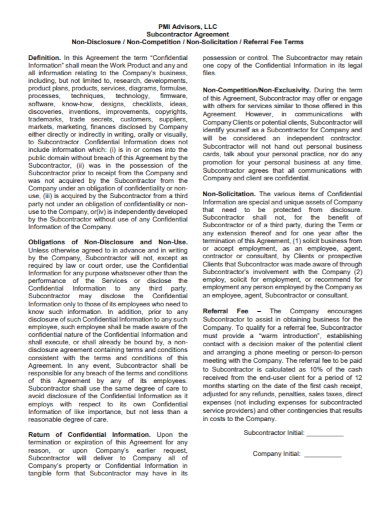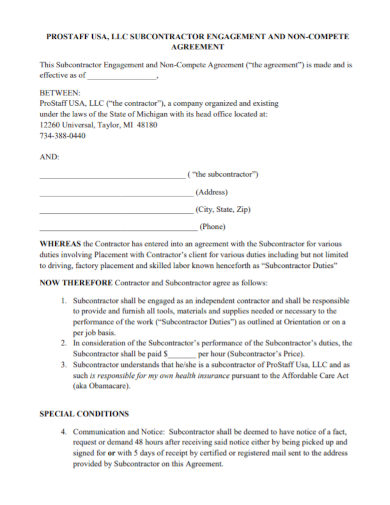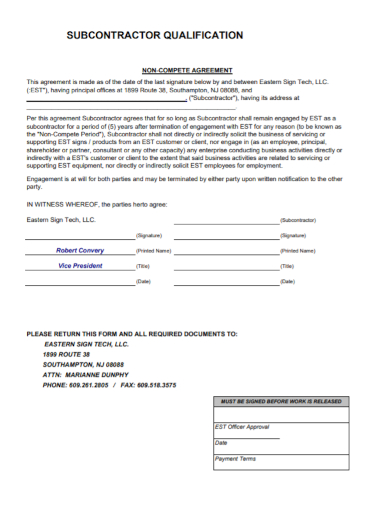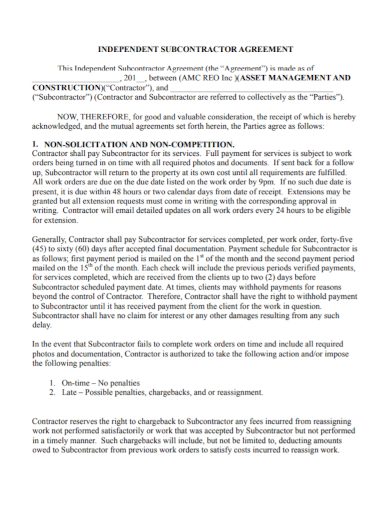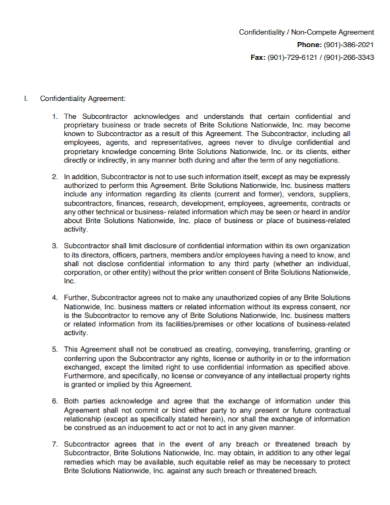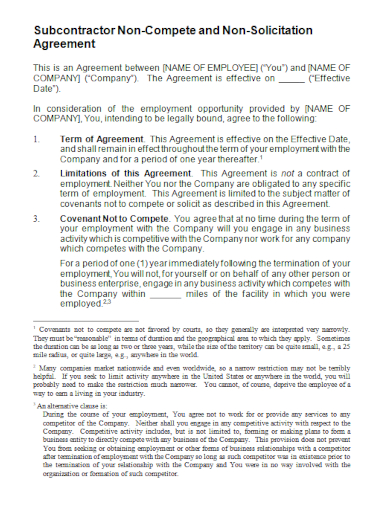When hiring a subcontractor, using contracts to protect your financial and legal rights can be extremely beneficial. Hiring subcontractors to do a portion of someone else’s work is a common practice in the construction industry. A graphic designer, for example, may hire a writer to write the text for a brochure they’re creating for a client. Working as a subcontractor is possible in almost any type of business or profession. A contract can be used to explain and clarify everything in your agreement’s terms and conditions, from the scope of the assignment to deadlines and payment arrangements, to name a few examples.
The use of a subcontractor agreement may appear to be a technique for contractors to protect themselves rather than subcontractors; however, in some cases, subcontractors may benefit more than contractors. These are the official written documents that outline the work to be done, the timetable, and any other critical components that must be considered during the construction process. When subcontractors understand all of these components, they can better defend themselves by demonstrating that they did what the contractor or owner expected them to do. Subcontractors can avoid some of the more damaging restrictions in their subcontractor agreements by conducting a thorough evaluation of their subcontractor agreements and refusing to accept unnecessary risks in their subcontractor agreements. Furthermore, the subcontractor agreement provides a framework for subcontractors to exercise their rights and increase the efficiency of their firm’s operations. Our sample subcontractor non-compete agreement samples are provided as a starting point for you to use as a template when developing your own. After you’ve become acquainted with the document, feel free to use these samples as suggestions or even templates to help you with the entire writing process, including how the document appears and functions in various situations and situations.
6+ Subcontractor Non-Compete Agreement Samples
1. Subcontractor Non-Compete Agreement Template
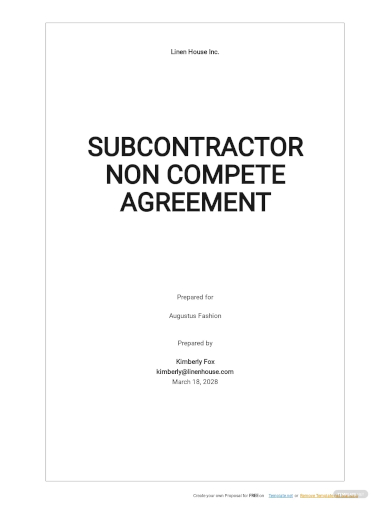
2. Subcontractor Non-Disclosure Non-Compete Agreement
3. Subcontractor Engagement Non-Compete Agreement
4. Subcontractor Non-Compete Agreement
5. Independent Subcontractor Non-Compete Agreement
6. Subcontractor Confidentiality Non-Compete Agreement
7. Subcontractor Non-Solicitation Non-Compete Agreement
What Is a Subcontractor Non-compete Agreement?
A subcontractor agreement is a contract used in the construction industry to define the scope of work between a contractor or project manager and a subcontractor. This demonstrates that all parties came to a mutually beneficial agreement and that the assignment will be completed successfully. To avoid putting themselves in unnecessary danger, subcontractors should thoroughly review the subcontractor agreement and ensure that all obligations are met. Numerous subcontractor agreements include specifics on the project’s duration, the scope of work, communication channels, and even payment terms, all of which are detailed. Pay when paid or pay if paid are terms used in some contracts to specify when a subcontractor is rewarded and when they are not. Other subcontractor agreements, on the other hand, treat both contractors and subcontractors fairly. In some cases, subcontractor agreements may be more advantageous to subcontractors than traditional verbal agreements, depending on the terms of the agreement. If a government agency enters into a contract with a large corporation, the major corporation may be responsible for the upkeep of the government agency’s commercial premises. The large corporation may contract out the upkeep of each location to a subcontractor. As a result, the subcontractor performs the maintenance services, and the large corporation profits by charging the government department more for those services than the government department initially paid the subcontractor. Individuals, businesses, and non-profit organizations are all eligible to work as government subcontractors.
How To Write a Subcontractor Non-Compete Agreement
While a subcontractor agreement may appear to benefit contractors rather than subcontractors, subcontractors may actually benefit from the arrangement. As the name suggests, this is a formal written document that outlines the work to be completed, as well as the expected completion date and other important factors to consider throughout the construction process. If subcontractors are aware of all relevant information and figures, they can protect themselves by demonstrating what the contractor or owner was supposed to perform. Subcontractors can avoid some of the more onerous provisions in their subcontractor agreements by thoroughly reviewing the clauses in their subcontractor agreements and refusing to take unnecessary risks. Subcontractors can also use the subcontractor agreement to exercise their rights and improve the operations of their own companies, among other things. A subcontractor agreement should include a number of critical clauses that must be followed. Subcontractors should be aware of a few key points as well. The variables listed below have the potential to influence the agreement, either positively or negatively.
- Scope of work
When you hire a subcontractor, make sure the scope of work is clearly defined in the agreement you sign. The scope of work is a list of the tasks that a subcontractor is expected to complete. It can be difficult to reach an agreement on a wide range of work, and subcontractors may be unable to meet deadlines. When a task is not written down completely, it is simple to assume that a subcontractor did not complete the project’s work. As a result, having a well-defined set of tasks is critical. - Supply chain
Another consideration when signing a subcontractor agreement is the amount of risk in the supply chain and other operational issues. The owner’s supply chain or commodities are not always completely under the subcontractor’s control. In these cases, the subcontractor should not be held liable for the owner’s actions. Some contracts, on the other hand, are intended to shift risk to subcontractors. Managing supply chain risk can be as simple as quickly reading and agreeing to the subcontractor agreement. - Defense and indemnification
They use the words “defense,” “insurance,” and “subcontractor agreements” frequently, and they are frequently used. A defense and indemnity clause is likely if you work on a project with a contractor. These criteria, on the other hand, can sometimes overburden the subcontractor. Some states have enacted legislation to protect subcontractors from unfair indemnity clauses in contract documents. In addition, other states have enacted legislation to ensure that they do not pay out excessive amounts of money. Defense and indemnification clauses should be included in subcontractor agreements between subcontractors. - Insurance, Bonds, & Liens
Contracts with subcontractors may contain clauses relating to subcontractor insurance, liens, and bonds, among other things. All subcontractors should be informed of the job’s insurance and bonding requirements. However, the subcontractor agreement may state that the subcontractor is not permitted to file a lien. Subcontractors cannot file a mechanic’s lien if they are not paid on time or at all. - Warranty
The work guarantee in a subcontractor agreement may differ from one project to the next, but this is project-specific. This contract clause benefits both the contractor and the subcontractor. A subcontractor’s reputation will be good if his or her work is good and well documented. If an accident occurs and something goes wrong, the subcontractor can deal with it while maintaining their good reputation. - Arbitration
Arbitration clauses are typically included in subcontractor agreements. Subcontractors are not treated the same way. Any claims must be resolved through binding arbitration rather than in a court of law. As a result, subcontractors will be unable to seek redress in court for issues arising from their contracts. A subcontractor may or may not be a problem for your company, but it’s something to consider when hiring one. - Conditional Payment
Subcontractor agreements are increasingly containing contractual terms that require payment only if work is completed. Pay if you pay and Pay when paid should be used to ensure that you pay before making a payment. Subcontractors may not be paid on time or at all as a result of this. This clause must be made clear to subcontractors before they sign their contracts. Otherwise, they risk losing their jobs.
FAQs
Does a subcontractor have to give notice?
If you are hiring someone else to do electrical work or build a fence, you must follow the main contractor’s instructions. Two weeks’ notice is the norm.
What are contract documents?
The tender and acceptance process is comprised of numerous documents. Tender documents include designs and drawings, specifications, a schedule of quantities and rates, a letter of acceptance, and any agreed-upon changes.
Who is responsible for a contractor?
Subcontractor agreements are increasingly including clauses requiring payment only if the work is completed. People who make payment arrangements that are contingent on receiving payment use phrases like “Pay if paid” and “Pay when paid.” As a result, subcontractors may not be paid for their work for an extended period of time, if at all. It is critical that subcontractors understand this clause before signing contracts. Otherwise, they risk losing their jobs.
Employee and subcontractor are not synonymous. Subcontractors are individuals who work for themselves rather than for the contractor. They work independently and make their own decisions about how to complete their tasks. It is not always easy to distinguish between an employee and a subcontractor. The contractor’s responsibilities change if the subcontractor is an employee (such as payment of superannuation contributions). A subcontractor’s legal rights and responsibilities are not the same as those of an employee.
Related Posts
FREE 10+ Trial Agreement Samples In MS Word | Google Docs | Apple Pages | PDF
FREE 9+ Shop Rental Agreement Samples [ Commercial, Lease, Tenancy ]
FREE 10+ Charter Agreement Samples In MS Word | Google Docs | Apple Pages | PDF
FREE 10+ Mentoring Agreement Samples In MS Word | Apple Pages | PDF
FREE 10+ Partner Agreement Samples In MS Word | Google Docs | Apple Pages | PDF
FREE 10+ Individual Agreement Samples In MS Word | Google Docs | Apple Pages | PDF
FREE 10+ Strategic Agreement Samples In MS Word | Google Docs | Apple Pages | PDF
FREE 10+ Equity Agreement Samples In MS Word | Google Docs | Apple Pages | PDF
FREE 10+ Producer Agreement Samples in MS Word | Apple Pages | PDF
FREE 10+ Grant Agreement Samples In MS Word | Apple Pages | PDF
FREE 8+ Meeting Agreement Samples in MS Word | Google Docs | Apple Pages | PDF
FREE 10+ Community Agreement Samples In MS Word | Google Docs | PDF
FREE 8+ Real Estate Option Agreement Samples in MS Word | PDF
FREE 10+ Call Option Agreement Samples In MS Word | PDF
FREE 10+ Advertising Agreement Samples In MS Word | Google Docs | Apple Pages | PDF

